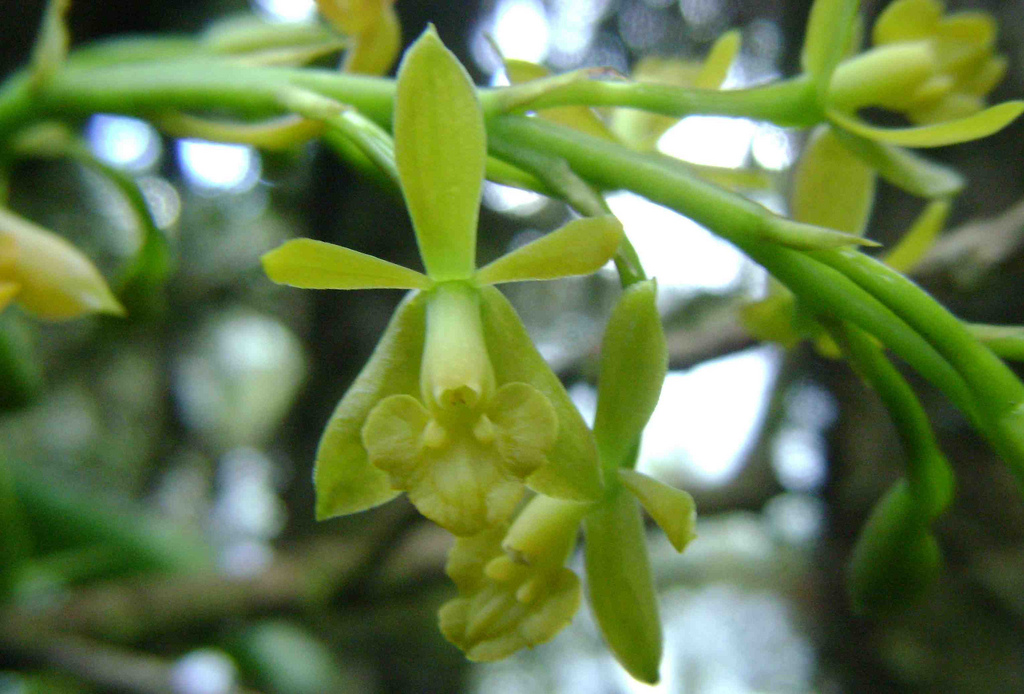

Epidendrum odontospathum Rchb.f. 1878 GROUP Odontospathum
Photo by © Eddy Cervantes Zavala
Photo by © Erica Moron de Abad
Photo by Ecuagenera and their Ecuador Orchid Website
Drawing by R Jimenez and AMO Herbario Website




Common Name or Meaning The Toothed Spathe Epidendrum
Flower Size .8 to 1" [2 to 2.5 cm]
Found in Peru and Bolivia on the upper slopes of the Cordillera Oriental of the Andes in elfin forest of Polylepis sp., and “pajonal” with bushes and rocks, and riverside forest, on slopes at elevations of 2500 to 3600 meters as a small to medium sized, cold growing epiphyte with simple, canelike, laterally compressed, erect stems with 3 basal, non-foliaceous, scarious, imbricating sheaths and carrying 6 to 9, sub-erect with respect to the stem, alternate, articulate, coriaceous, somewhat conduplicate at the base, widely elliptic, apex rounded and short-bilobed, with a minute dorsal apicule, margin crenulate leaves that blooms in the fall on a terminal, paniculate, sub-erect, slightly arching, lax-flowered, much surpassing the apical leaf, peduncle 5 to 12 cm long, wide, laterally compressed, ancipitose; rachis 5.5 to 6 cm long, with 3 short, lax, few-flowered branches 4 to 5.8 cm long, each arising from a bract similar to the spathaceous bract but progressively smaller, 10.4 to 14" [26 to 35 cm] long, successively many to 30 flowered inflorescence with prominent, gradually much shorter towards the apex of the rachis, shorter than the ovary, triangular-lanceolate, acuminate, amplexicaul floral bracts.
"Epidendrum odontospathum belongs to the GROUP Odontospathum which is recognized by the sympodial, caespitose habit, laterally compressed stems, successive flowers and a generally sub-erect, paniculate inflorescence, the peduncle with up to 4 prominent, conduplicate, ancipitose bracts covering the lower part of the peduncle. The species is recognized by the wide, laterally compressed stem, the wide, apically bilobed leaves, the inflorescence with several large, conduplicate bracts, spaced on an ancipitose peduncle, with branches produced from each bract, flowers green, orange-yellow to brown, and the somewhat pandurate lip. Epidendrum humiloides Hágsater & E.Santiago (syn.: Epidendrum refractoides var. humile C. Schweinf.) has smaller plants, shorter leaves, a racemose inflorescence with 5 to 6 flowers, a clearly 3-lobed lip, and has a single elliptic, acute spathaceous bract. Epidendrum lezliae R.Vásquez & P.L. Ibisch from eastern Bolivia has a somewhat similar inflorescence, with the long, zigzag peduncle bearing prominent conduplicate bracts, non-resupinate flowers, but the margin of the lip irregularly serrate-denticulate; the inflorescence is racemose to paniculate. Epidendrum philippi Rchb.f. does not have any spathaceous bracts, and the infundibuliform leaf-sheaths are reminiscent of E. ardens of the GROUP Andean SUBGROUP Soratae, with large floral bracts perpendicular to the rachis." as E refractoides Hagsater etal 2013
Synonyms
References W3 Tropicos, Kew Monocot list , IPNI *Xenia Orchidaceae Vol 3 Reichenbach 1878; Repert. Spec. Nov. Regni Veg. Beih. 10: 71 Bolivia Schlechter 1922; Orchids of Peru Vol 2 Schweinfurth 1958 as E refractoides drawing fide; Fieldiana Biology, Vol 33, 1st Supple. to the Orchids of Peru Schweinfurth 1970; Icones Planetarum Tropicarum Plate 478 Dodson 1989 drawing fide; Icones Orchidacearum Peruviarum Plate 247 Christenson 1995 not = E pseudospathoides; Orchids of Bolivia Vol 2 Laelinae Vasquez and Ibisch 2004; Orquideas, Tesoro de Colombia Vol 2 Ortiz & Uribe 2017 drawing ok; Icones Orchidacearum 16[1] Plate 1607 Hagsater & Santiago 2018 See recognition section; Icones Orchidacearum 16[1} Plate 1648 Hagsater & Sanchez 2018 drawing/photo fide; Icones Orchidacearum 17(1) Plate 1721 Hagsater & Jimenez 2019 see recognition section; Icones Orchidacearum 17(2) Plate 1793 Hagsater & Jimenez 2020 see recognition section; Icones Orchidacearum 17(1) Plate 1798 Hagsater & Jimenez 2019 see recognition section; * Icones Orchidacearum 18(2) Plate 1880 Hagsater & Jimenez 2021 see recognition section; Icones Orchidacearum 18(2) Plate 1892 Hagsater & Jimenez 2021 see recognition section
--------------------------------------------------------------------------------------------------------------------------